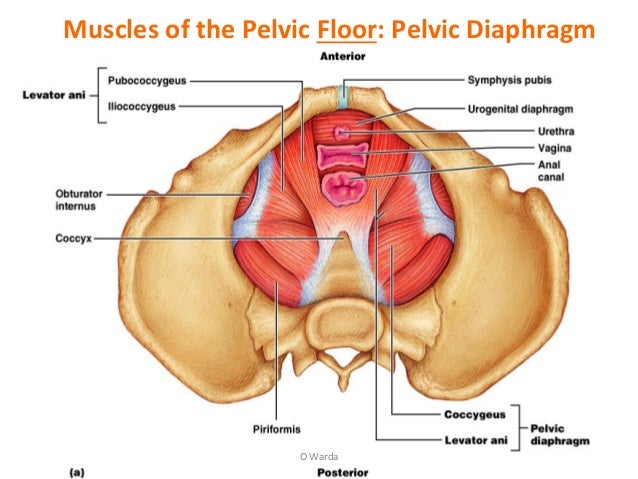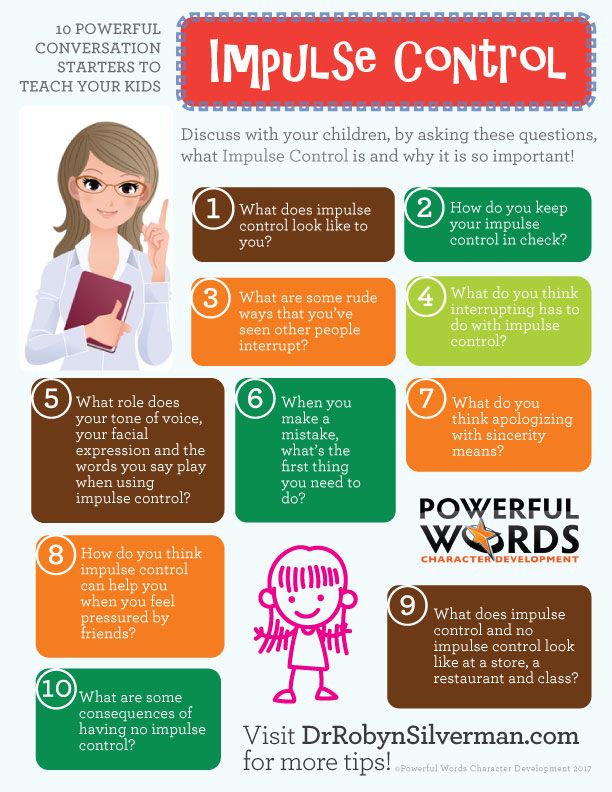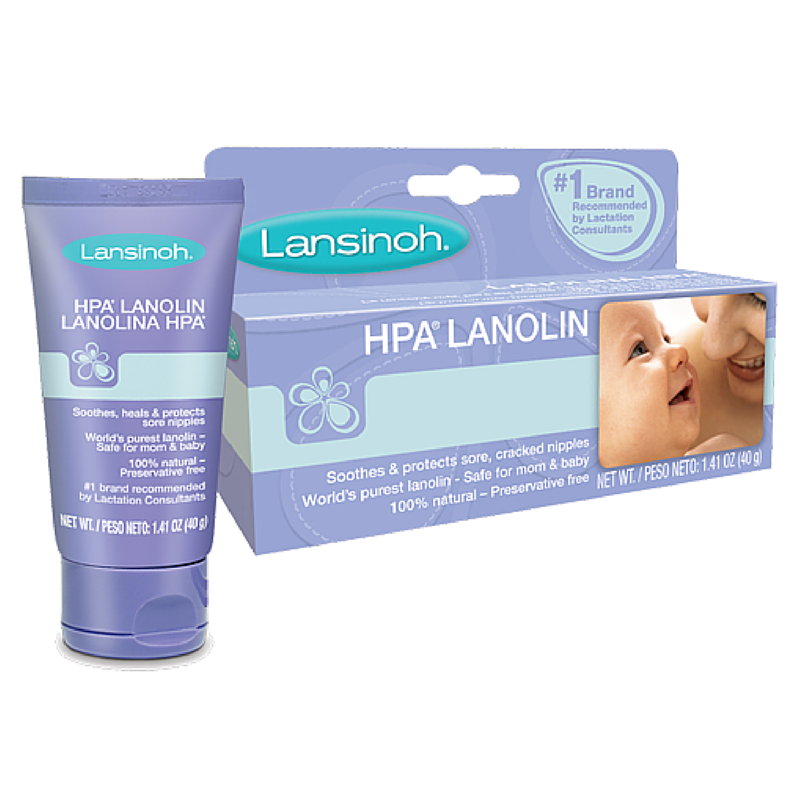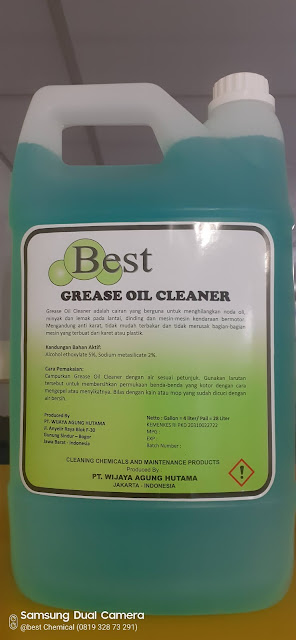When do you get stretch marks during pregnancy
Pregnancy Stretch Marks: Prevention & Treatment
Pregnancy stretch marks are a natural result of your skin stretching to make room for your developing baby and uterus. Not everyone gets them, but if they do accompany your pregnancy, stretch marks tend to fade over time. Either way, they’re a reminder of your sweet baby and a badge of honor for all the work of being pregnant! Read on to learn all about pregnancy stretch marks, including why they’re a natural part of pregnancy and what you can do to soothe your skin as it stretches and supports your little one.
What Are Pregnancy Stretch Marks?
Pregnancy stretch marks (also called striae) are natural, with more than 50 percent of pregnant bodies experiencing them. Stretch marks are not exclusive to pregnancy, however; men and women, whether pregnant or not, can develop these markings whenever the skin stretches rapidly. These streaky indentations in the skin can be pink, red, purple, or brown, depending on an individual’s skin color.
During pregnancy, stretch marks can appear on your stomach, breasts, buttocks, thighs and upper legs, hips, and arms. As stretch marks fade, they may change colors, appearing silvery or white, or even darkening.
Why Do You Get Stretch Marks During Pregnancy and What Are They Caused By?
Simply put, stretch marks may appear on your pregnant belly and body because your skin stretches to make room for your developing baby. The stress on your skin can cause these marks, which are not harmful. Contrary to popular belief, these streaks aren’t usually a result of normal pregnancy weight gain, but rather your skin stretching while hormone levels shift. Of course, weight gain can also cause the skin to stretch, but even those who gain a minimal or modest amount of weight during pregnancy may experience stretch marks. There are two main factors that can impact pregnancy stretch marks:
Hormones. Changes in hormone levels during pregnancy contribute to the development of stretch marks.
 During pregnancy, your adrenal glands produce the hormone cortisol. As cortisol levels naturally increase, the elastic fibers in your skin weaken, and as your skin stretches, it results in pregnancy stretch marks.
During pregnancy, your adrenal glands produce the hormone cortisol. As cortisol levels naturally increase, the elastic fibers in your skin weaken, and as your skin stretches, it results in pregnancy stretch marks. Heredity. Genetics are also a factor in whether you get stretch marks during pregnancy. If you experienced stretch marks at a younger age, such as with a growth spurt that stretched your skin during puberty, or your family members have them, it’s more likely that you’ll get those red, purple, pink, or brown streaks during pregnancy, too.
When Do Stretch Marks Appear in Pregnancy?
When should you expect to see stretch marks during pregnancy? Every pregnancy and body is different, but stretch marks are most likely appear sometime in the second half of your pregnancy. At this point, your baby bump starts to grow bigger and more quickly, putting further stress on the skin.
Some parents-to-be will start to see these markings in the second trimester, whereas others may not notice them until the last few weeks of the third trimester.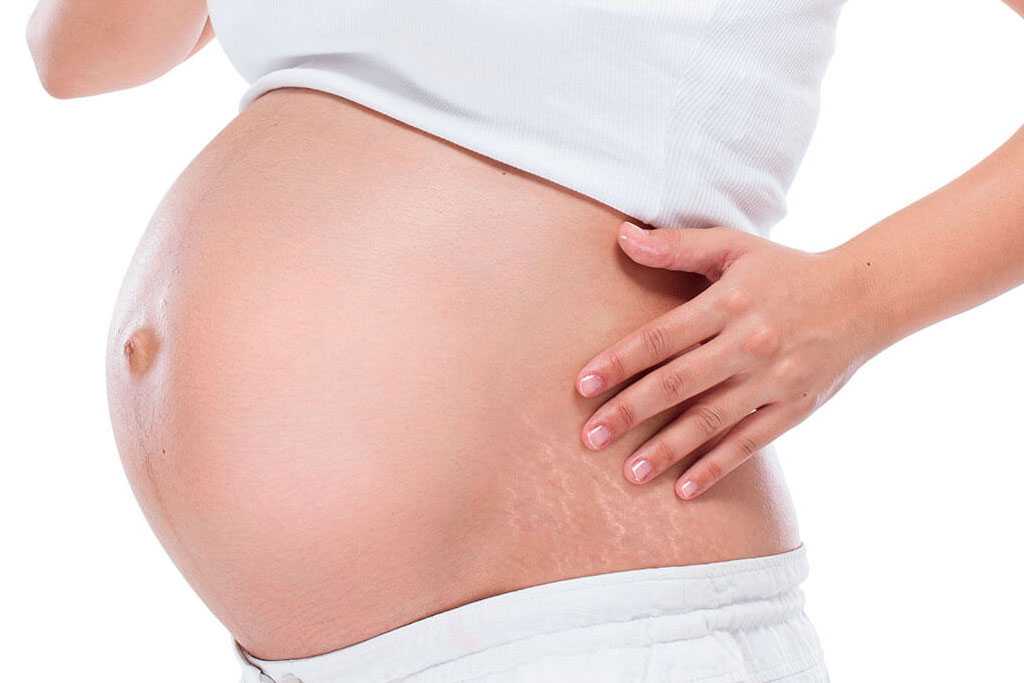 And remember, some don’t experience stretch marks at all!
And remember, some don’t experience stretch marks at all!
How Common Are Pregnancy Stretch Marks?
As mentioned above, more than half of pregnant people develop stretch marks, meaning there's a decent chance of having no pregnancy stretch marks. Likewise, it’s also possible to experience minimal pregnancy stretch marks on your stomach, breasts, thighs, or other parts of your body. Regardless, there are a few risk factors concerning pregnancy stretch marks:
Being pregnant at a younger age
Rapidly gaining weight during pregnancy
Using corticosteroids during pregnancy
Having certain genetic disorders (Cushing's syndrome or Marfan syndrome).
If you fall into any of the categories above, you have a higher risk of developing pregnancy stretch marks.
How to “Prevent” Stretch Marks During Pregnancy
Many people want to know how to prevent stretch marks during pregnancy, but unfortunately, there’s nothing you can do to avoid them altogether.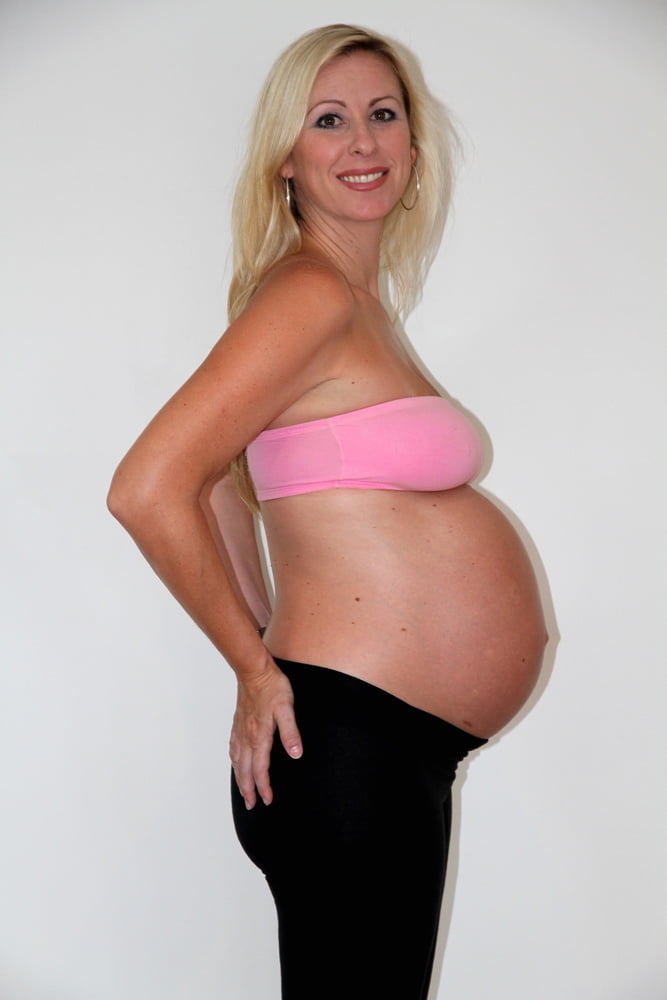 Stretch marks develop deep within your skin, specifically in connective tissues, so you can't prevent them from occurring with any topical or external treatment. Plus, because hormones and genetics are involved, stretch marks are pretty much out of your control.
However, some strategies could help reduce the risk of getting stretch marks and/or minimize their appearance. The key is to take these measures before your belly expands and keep them going throughout your pregnancy.
Stretch marks develop deep within your skin, specifically in connective tissues, so you can't prevent them from occurring with any topical or external treatment. Plus, because hormones and genetics are involved, stretch marks are pretty much out of your control.
However, some strategies could help reduce the risk of getting stretch marks and/or minimize their appearance. The key is to take these measures before your belly expands and keep them going throughout your pregnancy.
Use lotion or cream daily to keep your skin moisturized. This tactic can also help relieve itchy skin during pregnancy, whether you have stretch marks or not.
Stay hydrated by drinking lots of water, which may help keep your skin soft and less prone to stretch marks.
Avoid caffeine during pregnancy, which can increase your risk of developing stretch marks.
Maintain a healthy pregnancy diet with adequate nutrients.
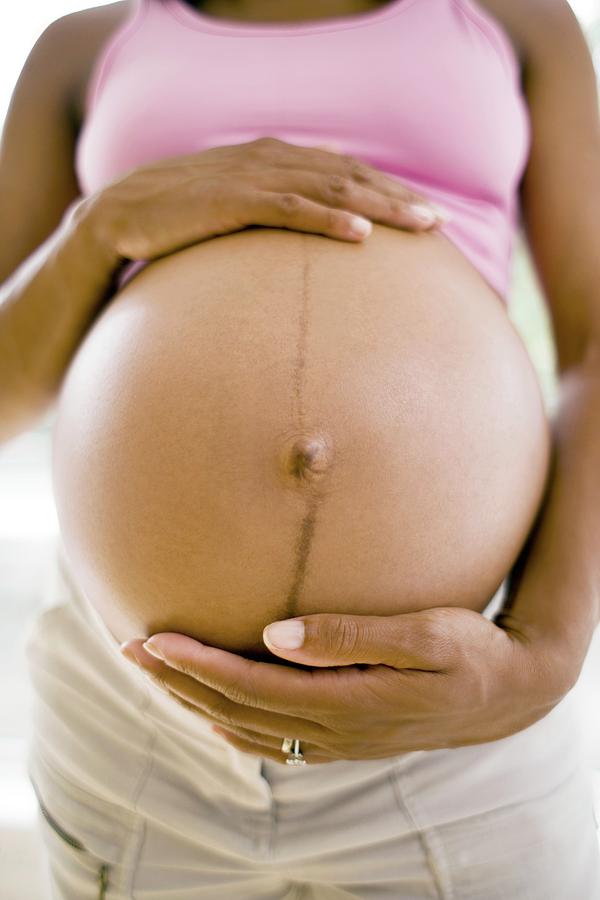 Eating a balanced diet rich in zinc, protein, and vitamins A, C, and D can help promote healthy skin.
Eating a balanced diet rich in zinc, protein, and vitamins A, C, and D can help promote healthy skin.
Stretch Marks After Pregnancy: Is It Possible to Get Rid of Them?
Do pregnancy stretch marks go away? Is it possible to get rid of stretch marks after pregnancy, and how long does it take for them to fade?
These common questions may arise when you’re still pregnant or when you’ve already given birth and are wondering how to deal with postpartum stretch marks. The good news is that stretch marks will typically fade after pregnancy. Because stretch marks are a form of scarring, the fading will be gradual, though, and they might not completely disappear.
Remember that stretch marks are a common and natural result of nurturing a baby inside your belly. Your body will inevitably change during pregnancy, and that’s expected, necessary, and completely OK. To learn more about how your body might adjust to being pregnant, check out our pregnancy calendar and know that you’re not alone in this journey—every pregnant person goes through it, too!
With that being said, we know that not everyone likes the look of pregnancy stretch marks. If you want to minimize or improve the appearance and texture of your stretch marks, talk to your healthcare provider. There are a few treatments to consider, and your provider will be able to recommend what’s best for you.
If you want to minimize or improve the appearance and texture of your stretch marks, talk to your healthcare provider. There are a few treatments to consider, and your provider will be able to recommend what’s best for you.
Creams. Although creams can’t prevent the formation of stretch marks on your pregnant belly (or elsewhere on your body), they may be able to lessen the appearance of these markings after pregnancy. Ingredients such as tretinoin and other retinoids derived from vitamin A can help boost collagen production on the skin’s surface, which may reduce the appearance of stretch marks.
Light and laser therapy. Likewise, laser and light therapies can also stimulate collagen production as well as improve elasticity.
Microneedling, microdermabrasion, and hyaluronic acid. Other dermatological treatments include microneedling and microdermabrasion, which could promote collagen growth and help the stretch marks blend into the surrounding skin.
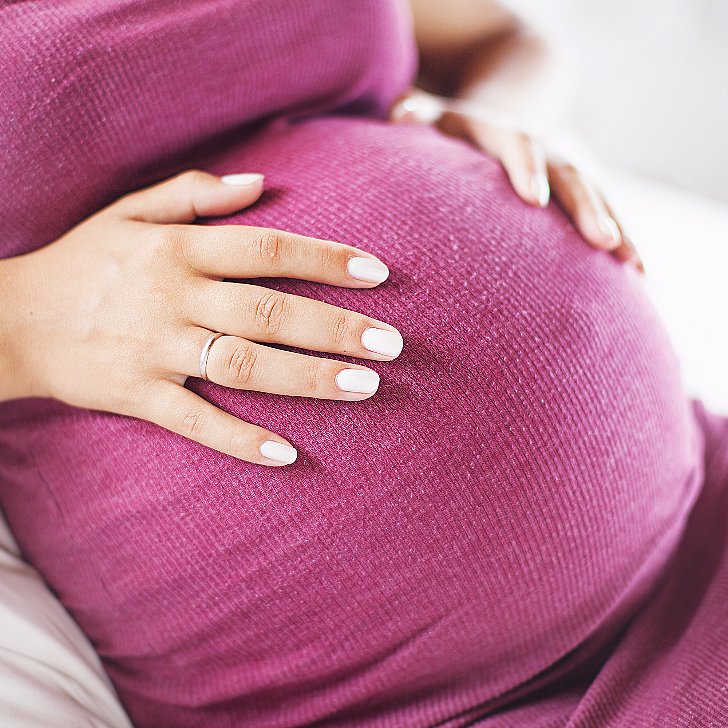 Applying hyaluronic acid daily may also help prevent and treat the appearance of stretch marks.
Applying hyaluronic acid daily may also help prevent and treat the appearance of stretch marks.
If you’re interested in these therapies, talk to your healthcare provider. The provider will be able to recommend an appropriate treatment and will let you know if you should avoid anything if you’re currently pregnant or breastfeeding.
The Bottom Line
More than half of all pregnant people experience stretch marks, a natural result of your skin stretching to make way for a developing baby and uterus. But stretch marks are out of your control, as hormones, genetics, and even skin type can impact whether or not you get them and influence their overall appearance.
There’s no surefire prevention strategy or cure for stretch marks during or after pregnancy. However, you can take a few precautions and opt for certain treatments to reduce your risk and improve the appearance of stretch marks postpartum. For example, during your pregnancy, try to keep your skin moisturized, stay hydrated, and maintain a healthy diet. And if you want to address stretch marks after pregnancy, talk to your healthcare provider about potential remedies, such as retinoid creams, laser therapy, or dermatological treatments.
Try to enjoy your pregnancy journey as much as possible, keeping in mind that normal symptoms such as stretch marks—and even those minor but annoying aches and pains—are a sign that you’re creating a little miracle inside your body. And if you’ve already welcomed your baby into the world, have fun and enjoy all those cuddles!
For example, during your pregnancy, try to keep your skin moisturized, stay hydrated, and maintain a healthy diet. And if you want to address stretch marks after pregnancy, talk to your healthcare provider about potential remedies, such as retinoid creams, laser therapy, or dermatological treatments.
Try to enjoy your pregnancy journey as much as possible, keeping in mind that normal symptoms such as stretch marks—and even those minor but annoying aches and pains—are a sign that you’re creating a little miracle inside your body. And if you’ve already welcomed your baby into the world, have fun and enjoy all those cuddles!
Stretch marks in pregnancy - NHS
Pregnancy stretch marks
Stretch marks on white skinCredit:
Regis Martin / Alamy Stock Photo https://www.alamy.com/stock-photo-stretch-marks-11435822.html?pv=1&stamp=2&imageid=C84B7D75-626A-4D81-8531-F39F5460B575&p=29849&n=0&orientation=0&pn=1&searchtype=0&IsFromSearch=1&srch=foo%3dbar%26st%3d0%26pn%3d1%26ps%3d100%26sortby%3d2%26resultview%3dsortbyPopular%26npgs%3d0%26qt%3dA625RY%26qt_raw%3dA625RY%26lic%3d3%26mr%3d0%26pr%3d0%26ot%3d0%26creative%3d%26ag%3d0%26hc%3d0%26pc%3d%26blackwhite%3d%26cutout%3d%26tbar%3d1%26et%3d0x000000000000000000000%26vp%3d0%26loc%3d0%26imgt%3d0%26dtfr%3d%26dtto%3d%26size%3d0xFF%26archive%3d1%26groupid%3d%26pseudoid%3d195878%26a%3d%26cdid%3d%26cdsrt%3d%26name%3d%26qn%3d%26apalib%3d%26apalic%3d%26lightbox%3d%26gname%3d%26gtype%3d%26xstx%3d0%26simid%3d%26saveQry%3d%26editorial%3d1%26nu%3d%26t%3d%26edoptin%3d%26customgeoip%3d%26cap%3d1%26cbstore%3d1%26vd%3d0%26lb%3d%26fi%3d2%26edrf%3d0%26ispremium%3d1%26flip%3d0%26pl%3d
Stretch marks on darker skinCredit:
NHSD/Annabel King
Stretch marks are narrow, streak-like lines that can develop on the surface of the skin.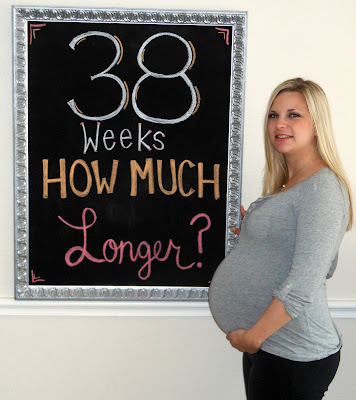 They can be pink, red, purple or brown, depending on your skin colour. They are common in pregnancy, affecting around 8 out of 10 pregnant women.
They can be pink, red, purple or brown, depending on your skin colour. They are common in pregnancy, affecting around 8 out of 10 pregnant women.
They usually appear on your tummy, or sometimes on your upper thighs and breasts, as your pregnancy progresses and your bump starts to grow. When stretch marks appear will be different from woman to woman.
The first sign you notice might be itchiness around an area where the skin is becoming thinner.
Stretch marks are not harmful. They do not cause medical problems and there is no specific treatment for them.
After your baby is born, the marks may gradually fade into paler scars and become less noticeable. They probably will not go away completely.
What causes stretch marks?
Stretch marks are very common and do not just affect pregnant women.
They can happen whenever the skin is stretched, for example when we're growing during puberty or when putting on weight. Hormonal changes in pregnancy can affect your skin and make you more likely to get stretch marks.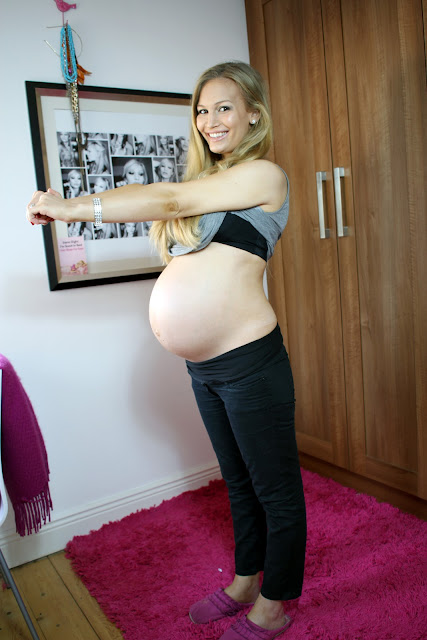
They happen when the middle layer of skin (dermis) becomes stretched and broken in places.
Whether or not you get stretch marks depends on your skin type, as some people's skin is more elastic.
Pregnancy weight gain
You are more likely to get stretch marks if your weight gain is more than average in pregnancy. Most women gain about 10 to 12.5kg (22 to 28lb) in pregnancy, although weight gain varies a great deal from woman to woman.
How much weight you gain may depend on your weight before you were pregnant.
It's important that you do not diet to lose weight when you're pregnant, but you should eat a healthy, balanced diet.
If you are worried about your weight, talk to your midwife or GP. They may give you advice if you weigh more than 100kg (about 15.5st) or less than 50kg (about 8st).
Preventing stretch marks
Some creams claim to remove stretch marks once they've appeared, but there is no reliable evidence that they work. There is also limited evidence about whether oils or creams help prevent stretch marks from appearing in the first place.
There is also limited evidence about whether oils or creams help prevent stretch marks from appearing in the first place.
Find out more about stretch marks, including possible treatments for them.
Find out more about other common health problems in pregnancy.
Video: Where does my pregnancy weight come from?
In this video, a midwife discusses where the extra weight in pregnancy comes from.
Media last reviewed: 27 March 2020
Media review due: 27 March 2023
Page last reviewed: 2 August 2019
Next review due: 2 August 2022
How to prevent stretch marks during pregnancy: 5 proven ways
Stretch marks appear first on the chest. This happens at the very beginning of pregnancy. At 17-18 weeks - on the skin of the abdomen. Other "problem" places are the thighs and buttocks.
If there are already stretch marks on the skin, then it will not be possible to completely get rid of them - you can only reduce or prevent them. Do you want your skin after childbirth to remain the same as before pregnancy? We talk about effective and proven ways to preserve her beauty.
Do you want your skin after childbirth to remain the same as before pregnancy? We talk about effective and proven ways to preserve her beauty.
What are stretch marks and why do they appear?
Stretch marks or, as they are also called, stretch marks, look like narrow stripes on the skin. On the body, they are immediately visible, since the damaged areas differ in color - from white to purple.
It is a mistake to think that after childbirth the skin will recover and regain its former beauty. The fact is that stretch marks during pregnancy appear due to skin ruptures due to its overstretching. Contribute to their appearance:
- hormonal changes. In the blood of a woman, hormones are produced to maintain pregnancy, but the production of collagen and elastin, the proteins responsible for the density and elasticity of the skin, is suspended.
- Rapid growth of the abdomen.
- Sedentary lifestyle.
- Muscle weakness.
- Hereditary predisposition.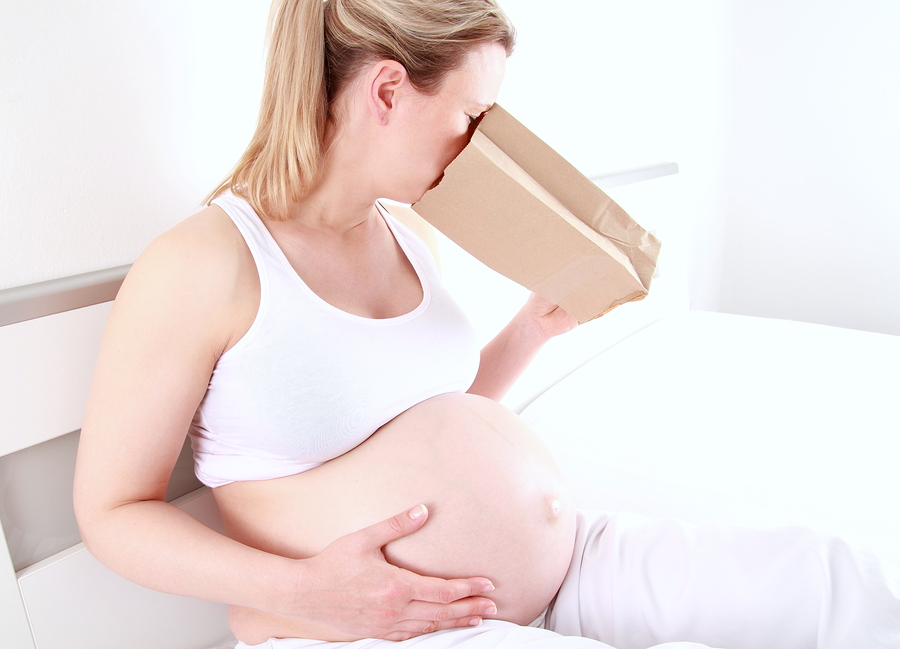
- Age. Most often, stretch marks appear in pregnant women aged 18 to 30 years.
- Improper nutrition - both before pregnancy and during gestation.
5 ways to avoid stretch marks
Avoiding skin breaks is easy if you take care of prevention in advance and do not forget to take care of your skin after childbirth. Regular care and little tricks help prevent stretch marks and promote rapid skin recovery. Revealing 5 secrets:
1. Wearing special underwear. First of all, this is a comfortable prenatal bandage that will support a growing tummy, which will prevent the appearance of stretch marks.
The sizes of products correspond to the girth of the hips under the stomach: 96, 100, 104, 108, 112.
An excellent solution would be to buy a universal bandage.
The PHARMEKONOM online pharmacy has universal bandages made of perforated material that allows the skin to breathe and promotes better moisture removal. Their sizes:
Their sizes:
- 100.104;
- 108, 112.
The range also includes products without perforation - they perform all the same functions as perforated ones, but they need to be worn only on underwear. These are products in sizes:
- 100, 104;
- 108, 112;
- 116, 120;
- 124, 128.
| Table for determining the size of the universal bandage | ||||
| Band size | 100, 104 | 108, 112 | 116, 120 | 124, 128 |
| Hip circumference under belly (cm) | 93 - 100 | 101 - 108 | 109 - 116 | 117 -124 |
Universal bandages are recommended to be worn from 20-24 weeks of pregnancy to support the growing tummy and after the birth of the baby in order to return the skin and muscles to their previous state. Please consult your doctor before purchasing this product.
Please consult your doctor before purchasing this product.
2. Proper nutrition. To keep the skin tight and elastic, eat more berries, fruits, vegetables, boiled fish and nuts. These products contribute to the production of proteins that are deficient during pregnancy - collagen and elastin. If we talk about meat, then the leader in the content of collagen is beef.
3. Movement. Reasonable activity during pregnancy helps keep the body and skin in good shape. You can walk and swim, do special exercises, but first consult your doctor.
4. Weight control . Normally, during pregnancy, a woman gains weight from 10 to 15 kg. With insufficient skin care, stretch marks may appear on her body, and if the expectant mother has gained more than 15 kg, the likelihood of “ruptures” is rapidly increasing.
5. Use of special cosmetics.
Cream 9 months. It prevents the appearance of stretch marks and fights existing ones. It contains highly active natural ingredients that soften, nourish and tone the skin, improve blood circulation, promote the breakdown of fat, and prevent the appearance of cellulite.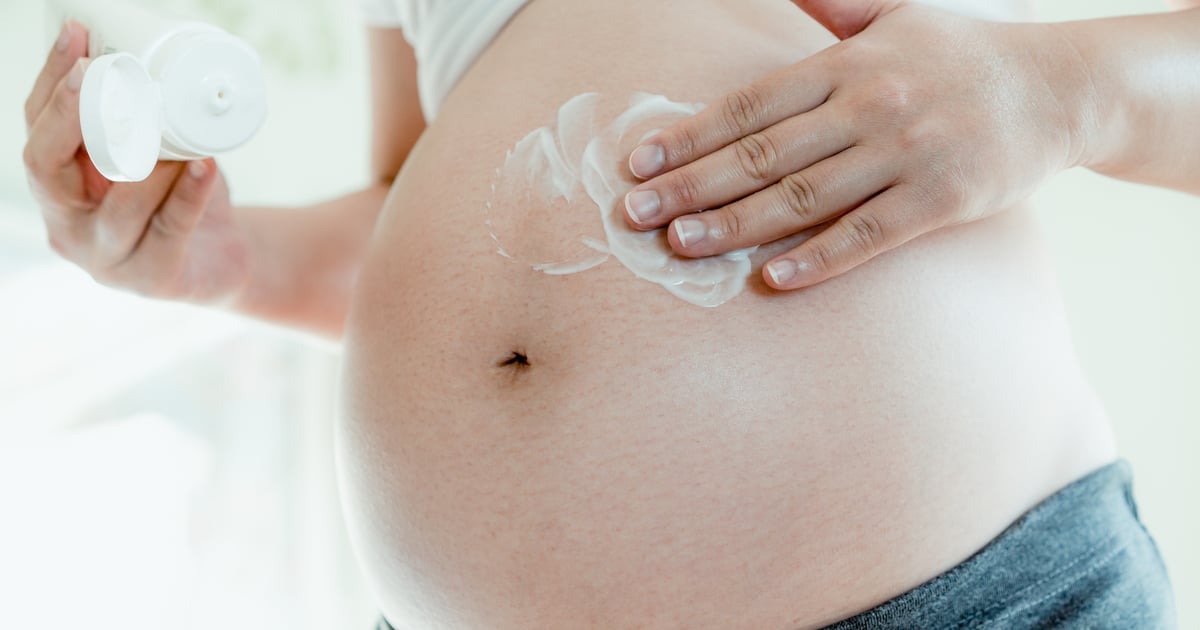 For best results, start using it at the very beginning of your pregnancy.
For best results, start using it at the very beginning of your pregnancy.
Balm Our mother (Mama Comfort). This product contains highly effective natural extracts that affect the skin in a complex way:
- Fucus nourishes and tightens, helps to eliminate stretch marks and reduce cellulite;
- green tea moisturizes and improves elasticity;
- horsetail and nettle smooth out irregularities, make stretch marks less noticeable, and some eliminate them;
- ivy contributes to the production of proteins, due to the deficiency of which stretch marks appear;
- Meadowsweet has an anti-inflammatory effect.
The balm contains green coffee oil, which has an anti-cellulite effect, and hyaluronic acid, which fills stretch marks and makes them less deep.
PHARMEKON pharmacies customers like 2 more effective pharmacy products: Our Mom cream with hyaluronic acid and horse chestnut - an ingredient that rids the skin of even old scars.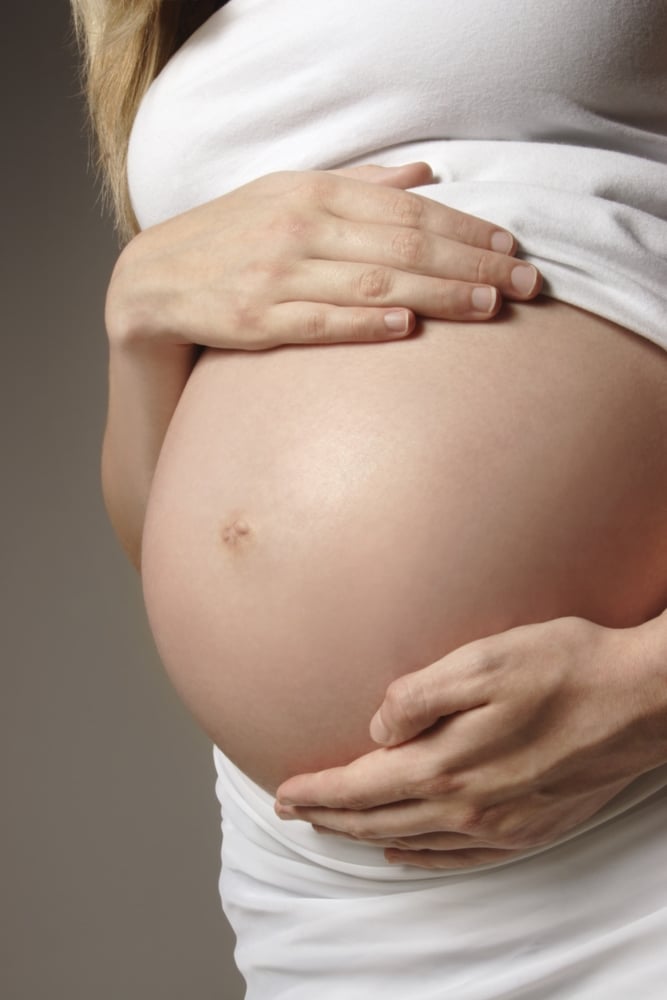 And SANOSAN cream with chitosan. This substance heals wounds without scarring, therefore it is actively used in cosmetology for the treatment of stretch marks.
And SANOSAN cream with chitosan. This substance heals wounds without scarring, therefore it is actively used in cosmetology for the treatment of stretch marks.
Where can I buy these goods cheaply?
In PHARMECONOM pharmacies you will find prenatal and universal bandages, as well as cosmetics for stretch marks at attractive prices.
Stretch marks - the whole truth - articles from the specialists of the clinic "Mother and Child"
Brezgunova Svetlana Leonidovna
Obstetrician-gynecologist
Clinic "Mother and Child" Togliatti
What is it
Stretch marks are also called striae. They appear in any area of the body, but more often occur in those places where there is a large amount of fat. The most common locations for are: chest, abdomen, armpits, shoulders, hips, back and buttocks.
Stretch marks look like stripes on the skin, and their color changes over time. "Fresh" stretch marks are pinkish-red in color, the skin on them is slightly convex. Gradually, the striae increase in length and width, become bluish-violet, and eventually become discolored. This happens because at first there are still blood vessels inside the striae, which is why initially the stretch marks have such a bright color. Then the blood supply at the site of the stretch marks stops, the vessels become empty, the resulting skin defect is filled with connective tissue and the stretch marks become white. Since there is no pigment in the connective tissue, even under the influence of sunlight, the stretch marks remain white. Moreover, against the background of tanned skin, they become more noticeable.
Gradually, the striae increase in length and width, become bluish-violet, and eventually become discolored. This happens because at first there are still blood vessels inside the striae, which is why initially the stretch marks have such a bright color. Then the blood supply at the site of the stretch marks stops, the vessels become empty, the resulting skin defect is filled with connective tissue and the stretch marks become white. Since there is no pigment in the connective tissue, even under the influence of sunlight, the stretch marks remain white. Moreover, against the background of tanned skin, they become more noticeable.
Why they occur
It seems that the reason for the appearance of stretch marks during pregnancy is clear at first glance: the expectant mother's belly grows, the skin stretches, and stretch marks form. Why, then, do they not occur in all expectant mothers? And is their appearance associated with weight gain? After all, it has been noticed, for example, that the likelihood of stretch marks does not depend on the size of the abdomen during pregnancy.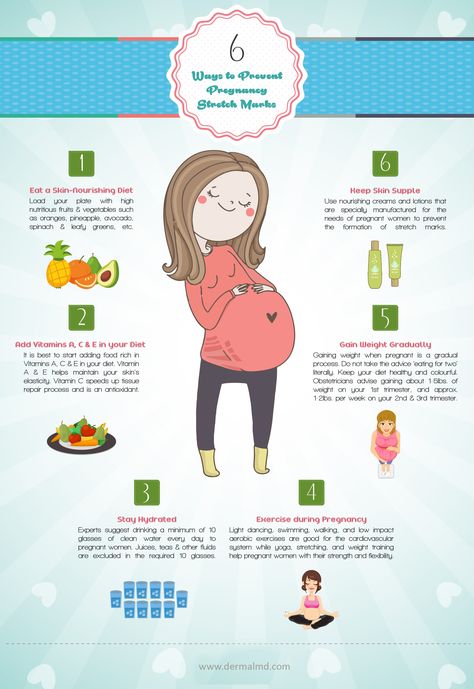
Stretch marks may appear in a woman with a small tummy, while a woman expecting twins will bypass this problem.
Why is this happening? Several factors come into play here. Yes, indeed, one of the reasons for the appearance of stretch marks is weight gain, but it is not so much the number of kilograms gained that is important, but how quickly a woman gained them: the faster the expectant mother gains weight, the higher the risk of stretch marks. That is why even with a small increase in weight, stretch marks can appear. The second reason for stretch marks is hormonal imbalance. During pregnancy, the amount of estrogen and cortisol decreases, resulting in a violation of the synthesis of skin and connective tissue proteins - collagen and elastin. Namely, with the help of these proteins, our skin can stretch well and restore its elasticity.
If there is not enough collagen and elastin, then the skin becomes brittle and thins faster, eventually, it tears in some areas, and then scar connective tissue forms in the places of tears .
And here is how the future mother's body will behave during pregnancy: whether there will be sharp jumps in weight and hormonal imbalance (which means that stretch marks will appear or not, it is impossible to predict).
What to do?
Let's just say that There is no 100% effective treatment for and prevention of stretch marks. For example, most creams, lotions, gels for the prevention of stretch marks simply contain moisturizing ingredients and help soften the skin, but do not affect the balance of hormones. Therefore, these remedies cannot prevent the appearance of stretch marks if hormonal disorders have occurred. Yes, and after childbirth, various laser procedures, peelings and resurfacing will not get rid of stretch marks at all, they will simply make them more invisible.
But this does not mean that we should give up and do nothing. You can do just a lot of things: even if you do not achieve a 100% effect, there will still be benefits.
– Monitor nutrition and avoid sudden weight fluctuations. Do not forget to eat protein foods - protein, together with zinc and vitamin C, stimulates the production of collagen, which gives the skin elasticity. If you don’t feel like meat yet, include fish, dairy products and legumes in your diet - these are also sources of healthy protein.
– Avoid sweets – sugar inhibits collagen renewal, the skin loses its elasticity and water, becomes dry, sluggish, its elasticity decreases.
- From the first days of pregnancy constantly nourish and moisturize the skin . To do this, use creams, gels, lotions with collagen, elastin, and vitamins C and E . The main thing is that these drugs must be approved for use during pregnancy. Before you buy this or that product, carefully read the instructions and the composition of the drug. Find out the mechanism of action of biologically active substances of a cosmetic product from a sales assistant.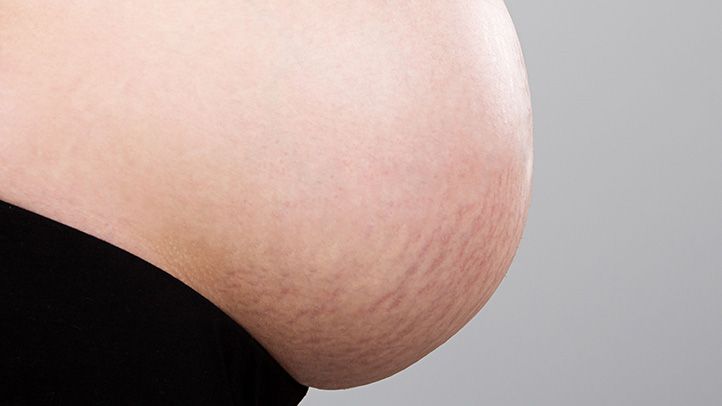 If you still have doubts, consult with your obstetrician-gynecologist. Look into your wallet and make a choice.
If you still have doubts, consult with your obstetrician-gynecologist. Look into your wallet and make a choice.
- If finances allow, do salon procedures for body moisturizing that are allowed during pregnancy (seaweed wraps, for example), if not, limit yourself to ordinary skin moisturizing, it is also effective.
- Regularly take a contrast shower : it tones and firms the skin, and problem areas receive the blood flow they need. You can massage individual parts of the body alternately with cold and warm jets. Just don't aim the jet directly at your stomach.
– After showering, do not dry your body, just pat it dry with a towel. You can do light pinching self-massage using moisturizing creams or natural vegetable oils (such as olive or linseed). Massage promotes the removal of excess fluid and activates the work of blood vessels - they quickly carry nutrients throughout the body. Important: when massaging the abdomen and chest, massage only the sides, thighs and legs.
– Swim : the contrast of water and air temperature, active physical activity also contribute to the prevention of stretch marks.
- During pregnancy , wear special bras, they will support enlarged breasts and prevent skin from overstretching.
Even if stretch marks appear, don't get upset. It has been noticed that if you immediately start a set of preventive measures (moisturizing the skin, proper nutrition, water procedures), then often stretch marks do not spread further. And if you start prevention from the first days of pregnancy, they may not appear at all.
REMINDER for moms
Start attacking stretch marks as early as possible: the younger they are, the less money and time it will take to eliminate them.
- Watch your diet, try not to gain weight abruptly.
- Daily moisturize and nourish the skin, not only the abdomen and chest, but also the thighs, buttocks, legs.
- Lead an active lifestyle: walk in the fresh air, play sports, swim.
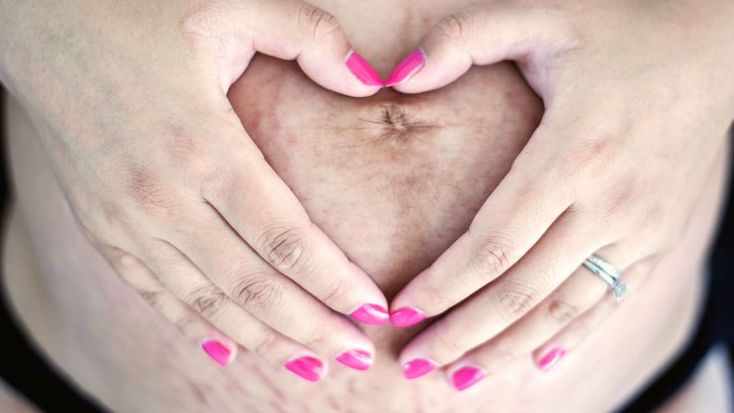
- Take a contrast shower, do self-massage.
- Wear the right underwear: a maternity bra is especially necessary for expectant mothers with large breasts
Note:
Stretch marks cannot be predicted. Even if during the last pregnancy there were no or, on the contrary, there were stretch marks, then there is no guarantee that the situation will repeat itself in the next pregnancy.
Here are the oils that will suit you:
- Jojoba oil is the most effective remedy: it is used for the prevention and elimination of skin stretch marks during and after pregnancy, as well as for weight gain and sudden weight loss.
- Essential oil of rosewood - helps to increase skin elasticity, also helps to dissolve small scars.
- Almond oil - especially effective for the care of areas of the body where skin elasticity is reduced.
- Grape seed oil - has a strong regenerating effect, improves skin elasticity.




